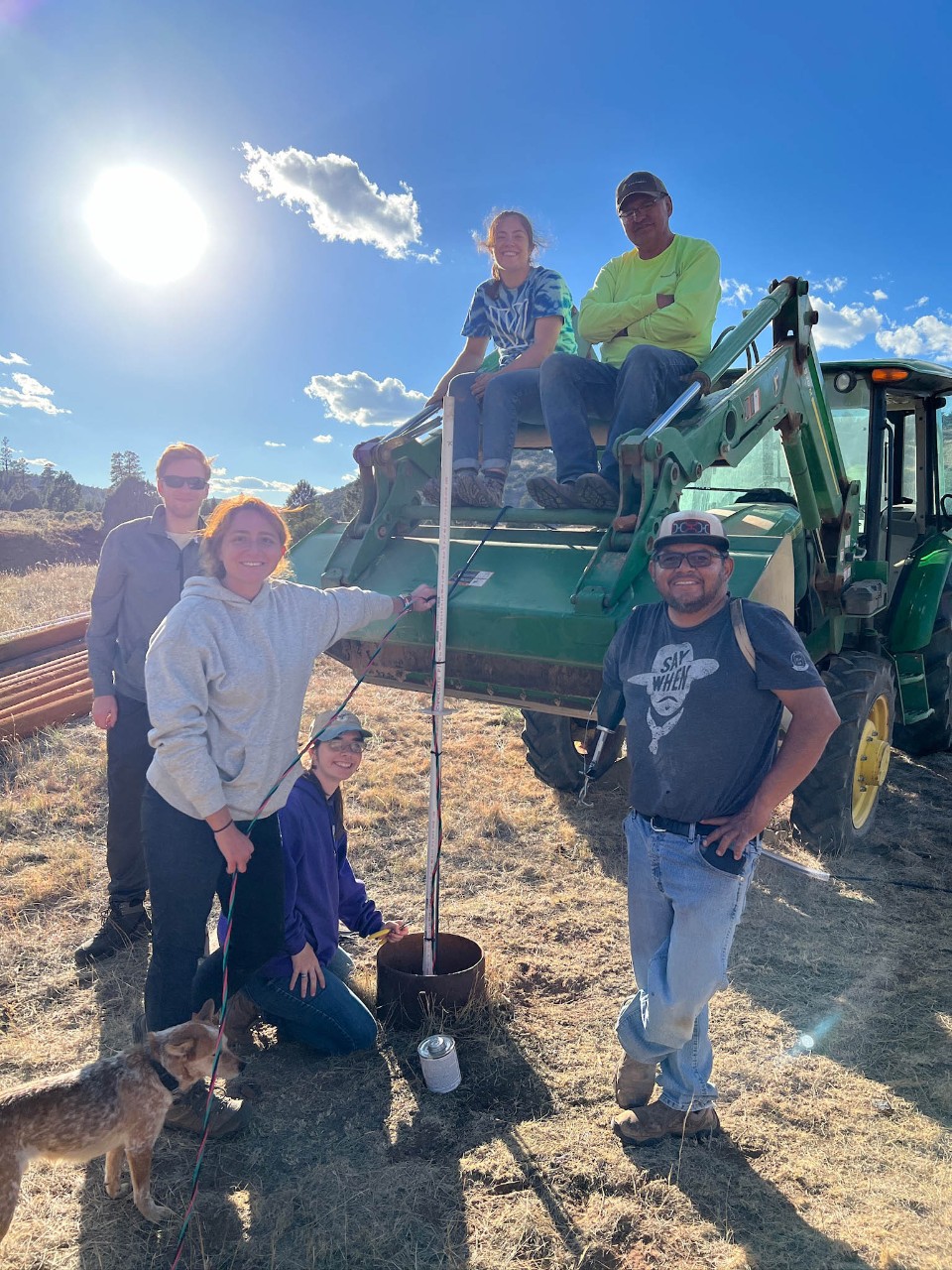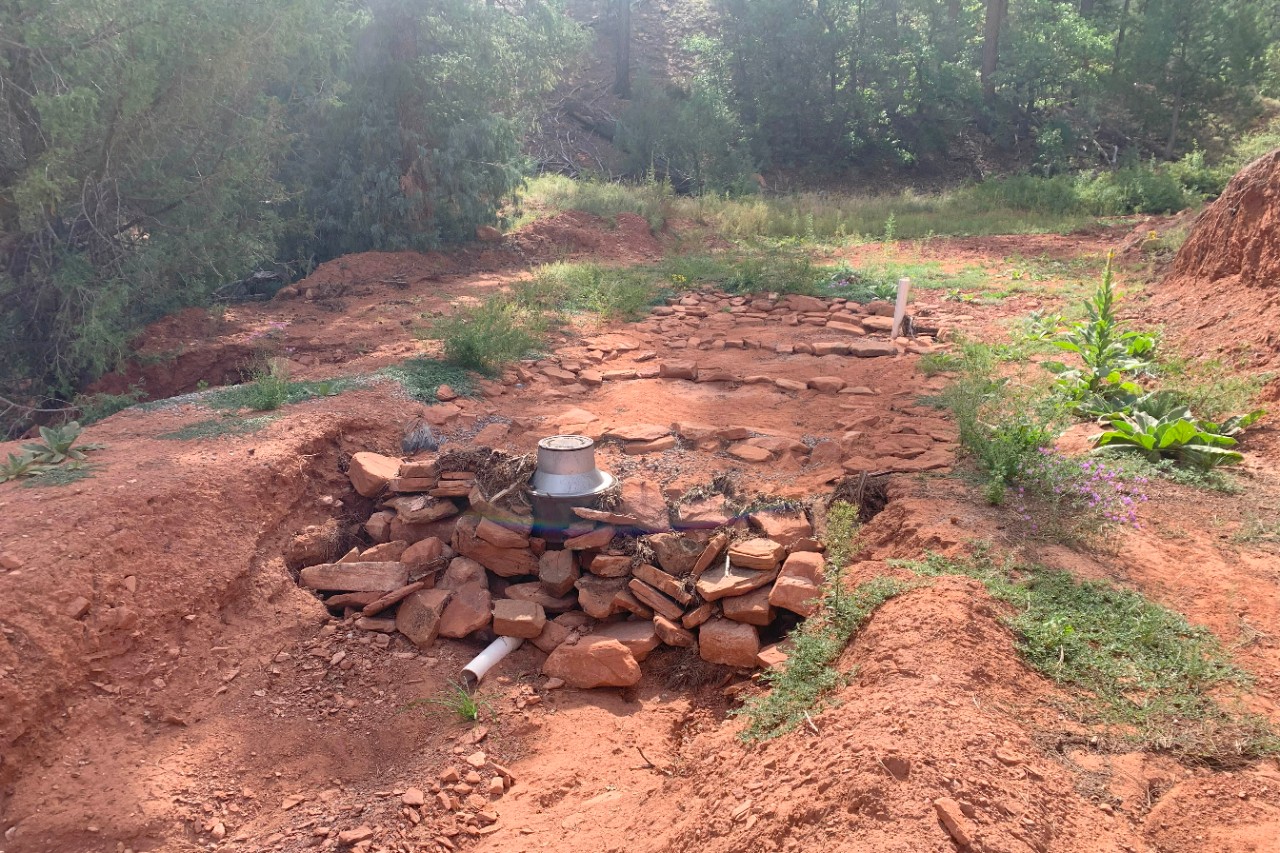Northrop Grumman Grant Supports Humanitarian Engineering Projects Within Navajo Nation

From left: Connor Redman ’25 CpE, Bridget LaSala ’21 CE, ’22 MSCE, Kerri Rose ’25 CE, Lauren Blanchard ’25 CLAS, and project partners Wayne Saytsitty and Alroy Billiman, with Wilber D. Canine, at work in the Four Corners Regions.
The Center for Humanitarian Engineering and International Development (C4HE) at Villanova University’s College of Engineering is widely recognized for its international service-learning programs, which are active in 12 countries around the globe. Now, thanks to the ongoing support of Northrop Grumman, C4HE has established its first domestic initiative with partners from the Four Corners region of the Navajo Nation.
Since 2021, C4HE has worked with the Buell Ranch community to explore potential solutions to water scarcity issues related to crop and livestock production. During this time, 22 Villanova Engineering students and four faculty members have contributed their expertise to the initiative, which includes the design of an elevated water-intake system to collect runoff and snowmelt, a surface reservoir for storing water and a high-efficiency drip irrigation system.
Water scarcity is well-documented in the Four Corners region, severely affecting crop intensity and output. The partnership with Buell Ranch and Horses for Heroes seeks to address these water shortages through the provision of educational workshops, technical assistance and the physical resources required to construct sustainable water systems.
The Buell Ranch, which is owned and operated by Alroy Billiman and his extended family, is home to 250 members of the Navajo Nation. Billiman, a veteran of the Iraq War, graduated from Horses for Heroes, a nonprofit in New Mexico that supports veterans working toward post-traumatic growth.
The underlying objective is to directly engage the Navajo Nation communities in Sawmill, Navajo Red Lake and Crystal, on the borders of New Mexico and Arizona, in sustainable agricultural practices, with a focus on indigenous livestock and crops. The foundation of the partnership is the provision of technical support to the Buell Ranch community around climate change mitigation strategies and sustainable agriculture.
The initiative seeks to build community members’ capacity to implement new technologies to augment indigenous agricultural practices and thereby increase the overall resilience of the community. This, in turn, provides unique learning opportunities for Villanova Engineering students, who are involved in offering their engineering expertise to this community.
“Working with the students from Villanova reminds me of being a squad leader in Iraq,” Billiman says. “When you work on a project together, the relationships and camaraderie that get developed are very authentic.”
This sustainable agricultural initiative is strongly aligned with the funding priorities of Northrop Grumman, which include military and veterans, the environment and STEM education. In 2021, Northrop Grumman provided seed funding to launch the partnership and facilitate the initial consultation and design work. It then augmented this support with an additional investment in 2022, which enabled the partners to construct the first phase of the elevated water-intake system, while expanding educational outreach and leadership training.
After C4HE was invited to submit a follow-up proposal in 2023, Northrop Grumman tripled the size of its initial grant award, allowing for growth in scope and impact. Building upon the prior work, the objectives for the 2023–2024 academic year are to implement the surface runoff intake system, construct the irrigation system and explore potential groundwater resources to supplement the water supply and optimize the system.
Over the Fall 2023 semester, Bridget LaSala ’21 CE, ’22 MSCE volunteered to serve as an on-site project lead for the initiative. Having just returned from a yearlong volunteer assignment as a math teacher at Amigos de Jesus in Honduras, LaSala was excited to undertake the assignment before embarking upon her career as a bridge designer with HDR.

The surface runoff intake system with constructed sand catchment is used to collect snowmelt from the surrounding mountains for irrigation purposes.
LaSala led a team of engineering students and community members who further optimized the inlet system and assessed and enhanced four wells that were recently discovered on the Buell Ranch. The first phase of the inlet system, which is used to collect snowmelt from the surrounding mountains and recharge groundwater supplies, was completed in 2022. A constructed sand catchment was added to the system as a water conservation measure, and over the next six months, the plan is to install some 1,200 feet of pipes to transfer the snowmelt to holding tanks and a pond for irrigation purposes.
The surprise discovery of four on-site wells, which had not been used in more than 70 years, greatly improved water availability at the Buell Ranch. Recognizing the wells’ potential to accelerate the community’s agricultural output, the assessment and optimization of these new water resources took precedence. By installing submersible pumps, the team determined the viability of the supply: the depth of each well, water flows and recharge rates, as well as water quality. Two of the four wells were then designated for agricultural purposes, and next steps include the installation of solar panels and permanent, solar-powered pumps at these two sites. The team believes the two wells and inlet system will be sufficient to support the planned alfalfa fields and 60 head of cattle.
The Rev. Rick Iannucci, OCF, former Green Beret and founding executive director of Horses for Heroes, says he’s impressed by the team’s progress. “I haven’t seen anything like this since working with Special Forces,” he says. “Operation Wildcat—the team from Villanova—is like family. They have all the elements of success: authenticity, relevance and compassion. When you start with the heart and trust your gut, then you are on the right path and have the courage to act. Only then can you use your intellectual ability to make a difference.”
Now that some of these systems are operational, the goal is to teach the community how to maintain them and demonstrate their effectiveness, including the return-on-investment, increase in water volume flows and increase in crop yields and/or livestock production.
LaSala, who participated in similar international immersion projects in Ghana and Ecuador as an undergraduate, says this domestic service-learning initiative was truly a unique experience.
“There are communities closer to home, here in the US, like the Navajo Nation, that face similar resource constraints as our international partners,” she says. “Communities like these could really benefit from the technical assistance and training C4HE can provide. Working with Alroy and his clan, with Rick and other community members was incredible and eye-opening. The entire experience allowed me to apply what I’ve learned in engineering courses and have greater, lasting impact.”
